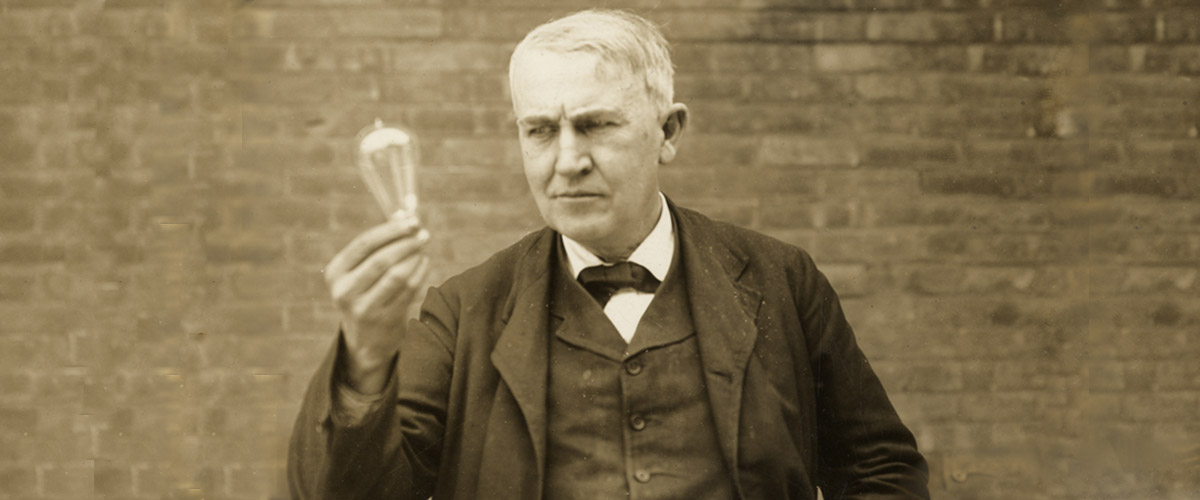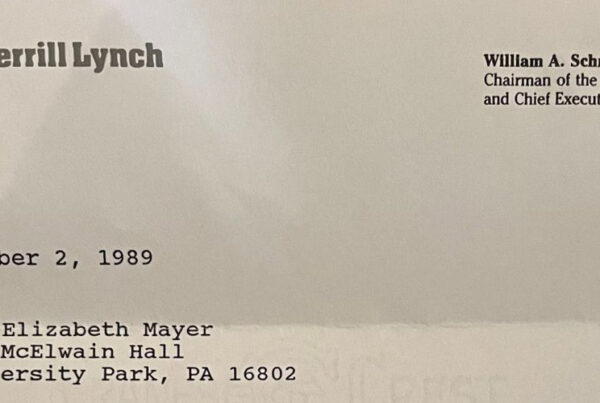
I’ve known Sarah for several years through my membership in the American Marketing Association’s Executive Circle. She has some really great content, ideas, programs, and services all around innovation. In fact, she has it in her DNA. Sarah is a great grandniece of Thomas Alva Edison.
I very much like her business model and her blog. Both are at the intersection of leadership, innovation, and communication. Read her second post as well, From Open to Seamless Innovation – 7 Lessons for Growth.
How Would Thomas Edison Reskill Today’s Workforce?
In scanning the recent bevvy of articles trumpeting slips in US competitiveness (Harvard Business School Research), I cannot help but wonder what Thomas Edison’s reaction would be to America’s current innovation stature. As the world celebrates Edison’s 166th birthday on Feb 11th, it prompts us to think about what Edison would be doing now to shape his own workforce, equipping it to drive an innovation colossus in the digital era.
A lover of data and trends, Edison viewed numbers and statistics with deep appreciation. As the man who invented one of the most extraordinary value-creating platforms of all time — the phenomenon we today call Research and Development (R&D) — Edison was a tireless experimenter who used notebooks to track every finding, every bit of data he and his teams generated.
Edison was also a visionary who pondered the future. Every day, he used his prowess as a master scientist and chemist to imagine not just new ways of shaping things that already existed, but new ways of perceiving the world that were meaningful and generated ongoing value – both in dollars and in terms of human assets.
Because Edison was able to powerfully devise alternative futures, he rarely viewed statistics as absolutes. So, while I don’t think Edison would be happy today with the present US workforce and its sliding innovation focus, he would also find reason for optimism. I believe Edison’s optimism would rest on the fact that a high percentage of what the US needs to power innovation and workforce competitiveness lies within its grasp.
Through a workforce “reskilling” process that has been vocalized by many, including guru Emily DeRocco — past president of the Manufacturing Institute based in Washington, DC — the country must, of necessity, undertake reskilling to remain relevant as a player in the global economy.
REVAMP AND REIMAGINE THE WORKFORCE
Importantly, however, Edison’s approach to reskilling looks different than platforms others have forwarded.
As Edison would envision it, the notion of workforce reskilling does not involve separate buckets of money solely earmarked for “innovation.” Nor would he advocate that this reskilling charge be led by a Chief Innovation Officer, or even a Chief Education Officer, or a Chief Manufacturing Officer.
Rather, Edison would view the reskilling challenge on par with changing all the engines on a once-sleek jet that’s losing altitude. The necessity is not just to replace the tired engines with turbo-models that can propel new altitude, but to revamp and reimagine the body of the jet as well. It is not about just changing one thing. (Indeed, that would risk an inglorious landing.) Instead, Edison would view this reskilling as changing multiple things simultaneously. He would view it as concurrent efforts falling within a bigger vision, a motivating goal to recapture American ingenuity itself.
In large measure, this reskilling engages qualities that are already intrinsic to our human design as thinking beings, as individuals capable of vastly creative power when placed within a framework of true collaboration.
I believe Edison would view reskilling the current US workforce – students and young employees included – in ways that not only provide capabilities to connect them with the technological accelerations of the digital era, but that also fundamentally reshape their engagement practices….the ways they connect with each other, and with the world.
RESKILLING AND INNOVATION ARE NOT MERELY BEST PRACTICES
Most of the time when we think about innovation, we view it as an array of “best practices.” Managers and C-suites love this type of thing, because best practices generally boil stuff down to a list that must be actioned in a linear, sequential way.
This is not how Edison viewed innovation. He viewed it as a force, a central, propelling heartbeat that was virtually inseparable from most facets of his laboratory – including his 150+ manufacturing, marketing, sales, and business operations. He viewed innovation as complex and simultaneous, yet a force that could ultimately be guided in ways that built momentum and drove forward movement as part of a continuous learning environment.
RESKILLING THROUGH COLLABORATION PROPELS INNOVATION
For Edison, collaboration proved to be the glue of his innovation colossus. Edison’s approach to collaboration represented a kind of built-in mechanism that allowed him to skill and reskill his employees as markets changed. Collaboration served as an almost invisible bond, a tapestry of happenings that operated almost unseen in the background at his storied Menlo Park and West Orange, New Jersey labs.
Within Edison’s collaboration process lay the seeds which skilled and reskilled his employees, allowing them to shift from working on projects related to capturing sound, to challenges of distributing electricity, capturing motion, or unlocking the secrets to store power.
Edison’s collaboration process – which I describe in my new book Midnight Lunch (Amazon Affiliate Link) – was a multi-phase system which “baked in” the power to unlock the brain’s creative wiring, to engage questioning, dialogue and debate that in turn propelled new perspectives. For Edison, collaboration was not “separate” from the things which centrally drive innovation. They were virtually inseparable from them.
RESKILLING WORKERS WAS BAKED INTO EDISON’S COLLABORATION PROCESS
As such, the reskilling efforts that were part of Edison’s collaboration approach operated simultaneously to the work itself. Through continuously reinforcing a handful of core practices, Edison’s organization was able to shape and reshape knowledge assets in ways that drove extraordinary value (Amazon Affiliate Link). Reskilling took place as part of real, live initiatives and operated regardless of hierarchy, pay grade, or work tenure.
Collaboration as Edison viewed it was a complex system, not a linear or sequential list of “best practices.” Among its many purposes, collaboration served as a vehicle for reskilling people through actual engagement with the problems they were trying to solve.
The term reskilling itself first evolved in 2010 from the UK, and was borne of challenges in Europe driven by escalating energy costs and deteriorating educational platforms. Reskilling as a movement focused on:
- Strengthening belief in the creative power of the individual
- Mentoring and receiving mentorship across many age brackets
- Understanding and engaging with smart devices and virtual networks
- Synthesizing information from traditional sources with information from networks that lie beyond companies, governments, or libraries
- Learning to establish rapport and work collaboratively with others to address challenges
If we look at Edison’s 4 phases of collaboration – Capacity,Context, Coherence, and Complexity – we see that the first salvo in the notion of reskilling was engaged by Edison decades ago. For Edison, reskilling thrusts drove important multiplier effects that powered Edison’s total innovation competitiveness. By focusing on these reskilling thrusts as part and parcel of his collaborative innovation efforts, Edison was able to skill and reskill his workforce in a manner which drove expansionary effects rather than merely additive ones.
I believe we can harness Edison’s reskilling principles, adapting them for our use in the digital era. If we consider Facebook’s trajectory versus Yahoo’s (prior to CEO Marissa Mayer’s tenure) we see the power of Edison’s reskilling approach in play.
PRIMARY RESKILLING FOCUS AREAS
Here are the primary reskilling focus areas which must be present in any organization, or any educational platform, to drive renewed innovation competitiveness across the workforce. Of note, many of these thrusts are already part of an extraordinary engineering curriculum spearheaded by The Kern Family Foundation, called KEEN:
- Questions First: Engage a small, diverse team in asking master questions at the outset of any innovation initiative. Find the biggest question and a handful of core sub-questions which flow out from them. View the master question as central, and core to everything. Consideration of if/then: Develop hypotheses which flow from the master question and its subparts, developing new context for the insights which emerge, and propelling thinking forward to a future state. This includes a consideration of the prospective value – qualitatively or quantitatively – which can emerge.
- Experimentation: Engage in hands-on experiments , which could include modern applications such as crowd-sourcing, or thought experiments, to forward diverse hypotheses. These can include simulations, laboratory-based work, community-based efforts, market research and more. (This is a key place where smart devices can add multiplying power using technology as part of the experimentation platform.)
- Debating and Distilling: Undertake casual dialogue to share questions, experiments, and insights within and across small teams, reshaping and understanding of the initial concepts. View the actual dialogue itself as a platform for value creation rather than raw absolutes. (Smart devices can be profitably leveraged here, too.)
- Prototyping and Synthesizing: Prototype and synthesize concept options or scenarios – using verbal, visual, three dimensional (ie tactile), technological (software based), or aural expression such as stories (narrative prototypes). This expands an understanding of the value-creation potential of the concept or platform.
- Owning Goals: Determine how the array of options or scenarios bring positive purpose and value-creation to the master question which launched the entire effort, inspiring others to join in actioning the solutions you’ ve gleaned rather than merely talking about it.
INSPIRATION AND PERSPIRATION
In looking to reskill the US workforce, if we can engage the core focus areas Edison used in his collaboration process, we can instill the seeds of “inspiration and perspiration” Edison so famously married. Through reskilling, we can leverage the power of smart devices and smart people. We can newly generate a positive view of the contribution of the individual to collaborative teams, and unlock the ingenuity we need for creating a workforce that can set the once-sleek jet airplane on a new, upward course…and a powerful future.
FURTHER READING ON INNOVATION & LEADERSHIP
Reprinted with permission from Sarah’s Company, PowerPatterns
Photography Source: Wikimedia/Public Domain, Circa 1910



